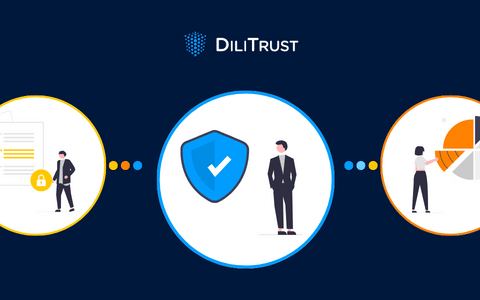This article was a Whitepaper published in 2021, click here to find our latest whitepapers.
As your company and board consider adding new members or replacing current ones, now is the time to reflect upon the power of mentorship within the board of directors. A mentorship program, whether it be created within your board of directors or is one that you pair with outside your organization, can make the orientation process easier for new members and accelerate their understanding. That mentor can be their go-to person and can help guide them, foster their learning, and encourage their participation.
Unlike a standard orientation, a mentorship program is meant to last over an extended period, ideally a year. This can help new members adjust, tackle the learning curve, and grow confident in their new role so that they can become a valuable addition to the board of directors.
A good mentorship program can improve your board in the context of both diversity and digital transformation.
DIVERSITY
In light of the #MeToo movement, diversity matters more than ever in your boardroom. Choosing diverse board members provides benefits that go beyond “just ticking a box.” Inclusivity can improve your overall boardroom decisions as well as better prepare your company for its next steps. It can enhance every aspect of your company, including its financial bottom line.
Here are three important reasons why you should consider adding diversity in your boardroom.
Diversity is much more than just gender and race.
When considering replacing or adding additional board members, you should think about gender and race and age, experience, mindset, and/or skill sets. When it comes to the make-up of your board, consider diversity as anything other than the status quo. When everyone on your board is selected because of “who you know,” your thinking can become and remain insular, which can hurt your company’s chance for true success.
If your company is looking forward and possibly considering a digital transformation, younger board members might have a varying viewpoint that could be helpful in that process. A board member with experience or skills from a different industry could also be an asset if your company is preparing for significant change.
In a study, it was found that women had greater representation on boards with tech profiles, an indicator of success for boards who are wanting to take their company through a digital transformation. Included in the hiring of women are young women, who can provide a differing viewpoint and the agile, fresh thinking required to help advance the board as a whole.
In order for a board to be able to work together and be effective, unity is imperative. In addition to candidates being assessed on their experience and demographics, it is important to consider their interpersonal skills. Can they communicate effectively? Can they work as a member of a committee and facilitate thoughtful interactions? Do their values and goals align with those of the board?
Diversity drives innovation.
It goes without saying that varying viewpoints account for diverse ideas. Adding new and diverse board members could be the missing piece in your company’s successful implementation of a new business strategy or in preparing for a dramatically different economic landscape.
Diverse boards are better prepared for risks and crises.
2020 has taught us all the importance of flexibility and agility. A diverse board is better prepared to assess risks and crises because they can better understand the implications of decisions. Those wide ranges of experiences and viewpoints can be critical components to effective corporate governance.
That’s why it must be so important to consider diversity in terms of constituencies. Who would better represent your talent pool? Your customers? Your stakeholders? Having a wide range of viewpoints can better help your board steer your company through the good, as well as the tough.
It should be noted that diversity for the sake of diversity will fail every time. Simple representation won’t work if there’s a lack in varying perspectives. That range of perspectives is crucial to the board’s being able to navigate dynamic issues.
So, while it is clear that having diverse board members is helpful to your company’s future, why is it difficult?
Adding diverse board members takes rethinking.
For most boards, finding additional or new members takes place based on “who you know.” Well, if your board is comprised of primarily traditional white men, with decades of experience working in a specific industry, it’s unlikely that they know many diverse, new, or enterprising candidates. Thus, relying solely on networking to fill positions on your board means the group is more likely to remain a homogeneous.
The board will need to adopt new ways of finding members. This may mean that your board members need to be more aggressive and thoughtful about their networking. They need to release old, ingrained ideas in order to have a diverse personal network.
Your board of directors may then consider posting the requirements for the board position to make sure it’s open to a broad applicant pool. Your board may need help creating the posting in question because the language they use may inadvertently discourage or leave out the diverse applicants they seek. This may lead to the belief that a wide pool of qualified and diverse applicants doesn’t exit, which makes it easier to give up on achieving the goal of having a diverse board.
In “Why Workplace Diversity is So Important, and Why It’s So Hard to Achieve,” Meir Shemla writes about how “there is often a mismatch between how organizations design diversity policies and how they implement them. Or to put it another way, what looks good on paper too often falls apart in practice.”
As described in “The Table in the Boardroom: Ways to Increase Diversity,” sometimes the job descriptions inevitably negate diverse applicants. Diverse candidates, such as women and people of color, may not have decades of industry experience simply because those opportunities weren’t available to them until recently. Requiring candidates to have decades of experience or other like reasons may inadvertently “count out” diverse applicants.
It should also be noted that “studies show that most women will only apply to a role if they meet every single requirement. Yet, men tend to apply if they only meet most of the requirements.” Therefore, if your board explicitly wants to recruit women, some requirements should be optional and others, that aren’t necessarily as important (such as a certain number of years of experience), should be removed altogether.
Your diversity goals should align with your organizational goals.
While the number of women serving on boards has risen considerably since 1997, “a study by the U.S. Government Accountability Office found that…at that rate, it could take more than four decades for women’s representation on boards to reflect the overall talent pool from which companies hire.” Being mindful of the language of your board member requirements, your board members’ personal networks, and creating programs better able to facilitate the success of new board members, like a mentorship program, can reverse these issues.
It can’t be ignored that choosing individuals based solely on their gender isn’t the best strategy for preparing these new board members for a long tenure on your company’s board of directors. However, mentorship programs can be beneficial to new diverse members. “Research shows that 88% of people who receive mentoring are successful in business, compared to only 50% of those who do not.”
Women in Governance is one such mentoring program that seeks to help women be further represented in senior management positions, such as on your company’s board, as CEO, chairwoman, president, director, or vice president.
Founded in 2010 by Caroline Codsi, Women in Governance supports women in their leadership goals, professional development, and business acumen.
This year-long program includes:
- Pairing mentor & mentees
- Coaching of mentors and mentees
- Training on developing best practices for a successful mentor and mentee relationship
- Training workshops
- A platform for sharing tools
- Unlimited access to numerous online resources;
- Virtual meetings of approximately 1.5 hours every 6-8 weeks with high-level mentors. (To be determined with the mentor.)
A mentorship program such as this one can best facilitate the long-term success of new diverse candidates. Women, in particular, can struggle to get the necessary mentorship and support that white men get more easily within their networks. However, mentorship has been proven to negate some of the differences that may have held women back in the past.
While including a mentorship program as part of the experience for your newest members can take time that your board of directors may not want to account for, the benefits of such a program cannot be denied. Your board should want members that will be in it for the long haul. Thus, a vigorous onboarding process and mentorship program for new members could help solidify the cohesion necessary to ensure that they are long-standing and helpful members of your company’s board.
Adding diverse candidates to boards, no matter the diversity in question, has been linked to tangible benefits, including increased profitability, for companies who have done so.
DIGITAL TRANSFORMATION
When your board is considering adopting new technologies and navigating your company through a vigorous digital transformation, a mentorship program can also help facilitate that change. Digital transformation is integral to the success of every company today. Thus, it’s even more critical that your board consider something such as a mentor/mentee program to help the best support this change.
A digital transformation is about how your company can best serve your customer. This definition provides clarity: “Digital transformation…transcends traditional roles like sales, marketing, and customer service. Instead, digital transformation begins and ends with how you think about, and engage with, customers. As we move from paper to spreadsheets to smart applications for managing our business, we have the chance to reimagine how we do business — how we engage our customers — with digital technology on our side.”
Digitization requires agile thinking and resilience, and it is more important now than ever with how much the pandemic accelerated every industry’s move into the digital market.
Your board of directors will need to lead the charge to ensure its success, which can be a hefty task. The end goal should be digital optimization for employees and customers to ensure maximum ROI. But is your board ready? Creating a mentorship program for your board to facilitate a digital transformation can have a greater impact than you might expect, and that out-of-the-box thinking can help your board of directors first understand and then champion digitization in a way you may not have realized.
For one, your board could look into partnering with the board of a company that has already been through a digital transformation. Pairing with mentors from that board could help your board learn about mistakes, growing pains, and what to expect going forward. That other company’s board may also have suggestions for new technologies to look into, companies or industries to explore, or ways to incorporate technology into the personal lives of the board members to better help them lead this transformation.
Keeping competition in mind, your company may want to look for an organization in a different industry. However, digital transformation is digital transformation, regardless of the industry or type of business, and your board can learn valuable experience from any board that has been through a digital transformation themselves.
Partnering with another company that’s already been through a digital transformation could help your board answer the following questions:
- How did the digital transformation impact your company culture, the employees, and its customers?
- What benefits did the company get from these changes?
- Were new employees hired to help make these changes?
- Was your company prepared for new technology?
- Did your employees have the skill sets necessary to move forward?
- Were your executives and managers confident in their employees and the success of the new technologies?
- Was everyone able to work together to facilitate the new changes?
- How bold was your board in the changes it decided to implement? Why or why not?
- Who was in charge of the digital transformation?
- How did the leader(s) cooperate with decision-makers?
- How were current employees trained to use the new technologies?
- Did your board need new members? Why or why not?
- How were misalignments addressed?
- Did your company use any external resources, and which would be ones would you recommend?
- Finally, how did you change how your board communicates with stakeholders, executives, leaders, employees, and customers to facilitate this digital transformation best?
Knowing the answers to these questions could best serve your board in understanding how they need to prepare for the next step in their process. In addition, we can learn from the experiences of others to best prepare ourselves for the step at hand.
Bringing on a CEO who has previously led a company through a significant digital transformation is one another way to achieve mentorship, as they can guide the board. Their experience, guidance, and leadership might be the missing element your company needs for thriving during this challenging transition period. While they would, of course, already be communicating with the board regularly during this transition period, they could also share their insight into how the board of their previous company navigated these concerns, or if their company didn’t have a board, how the CEO believed they would or should have handled it.
Your board may also want to consider pairing up with technology leaders that are already in your company. These are the people your company is trusting to stay informed on the latest innovations, and this more intentional relationship could help bridge gaps in understanding and help your board push back against outdated thinking.
A more intentional relationship like the one including a mentor and a mentee can also help your board more quickly adopt changes. Your company’s technology leaders will already be aware of the importance of being at the forefront of innovative technologies and can help the board move toward this with the urgency it deserves.
Your board of directors could also look into a “reverse mentoring” program. Amrop’s N Fellowship partners young computer engineering students with company CEOs. This is a unique opportunity for a company to connect with talented students at some of the top universities in the world on the cutting-edge of computer technology. These innovators are best suited for sharing with your company’s CEO new and valuable forward-thinking ideas. They could also share insights on new technologies and ideas on how your company could continue adapting and transforming.
Another unique mentorship program could be in pairing board members with a different constituency altogether. This could mean pairing them with stakeholders or employees. A mentorship relationship is vital for both parties and having a more close-knit relationship with this other constituency could help the board better understand the technological needs and concerns of that group. This could be helpful before adopting new technologies and addressing how your company currently uses its digital investments and what the user experiences are.
It’s important to focus on whether your current digital investments are being properly utilized to their full extent. A high-quality user experience by your employees ensures that, and when they fully utilize your digital investments, it maximizes profitability and helps customers.
While your board members may be all seasoned veterans, anyone can benefit from a mentor/mentee relationship. Your board can be creative on what kind of mentorship program it considers. For example, if you’re adding new or additional members or diverse candidates, you may want to consider a program such as the aforementioned Women in Governance to ensure their best, long-term success.
As you’re considering a digital transformation or adoption of new and exciting technologies, you may want to go even more out-of-the-box. Remember that diversity drives innovation, so something new could really propel your board, and thus your company, to the next level. Consider mentorship programs that pair your board with another company’s board. Work closely with your new CEO if that’s something that makes sense for your company and the direction you’re headed in.
Pair members of your board with leaders in technology so you can get hands-on help with new technologies and understand the urgency of adopting things now instead of lagging behind competitors. Do “reverse mentoring” and see what students at the forefront of cutting-edge technologies are doing and creating, or pair with a different constituency to see how they’re adopting technologies, what they need, and brainstorm ways you can work together to help improve in these areas.
We no longer have to be defined by the methods or ideas we had in the past. Both your board and your individual board members need to grasp that what worked before won’t work in the future. Methods and ideologies are changing, and diversity is the best way to prepare your company for these kinds of issues. Don’t let outdated ideas hold your company back from the kind of profitability possible with more cutting-edge thinking.


